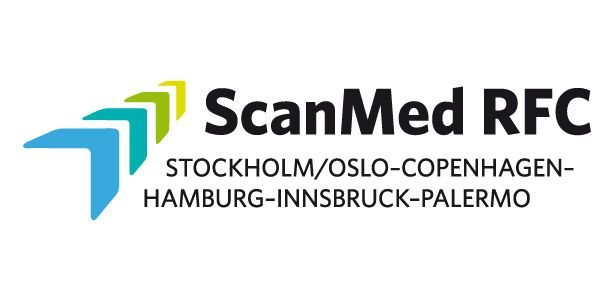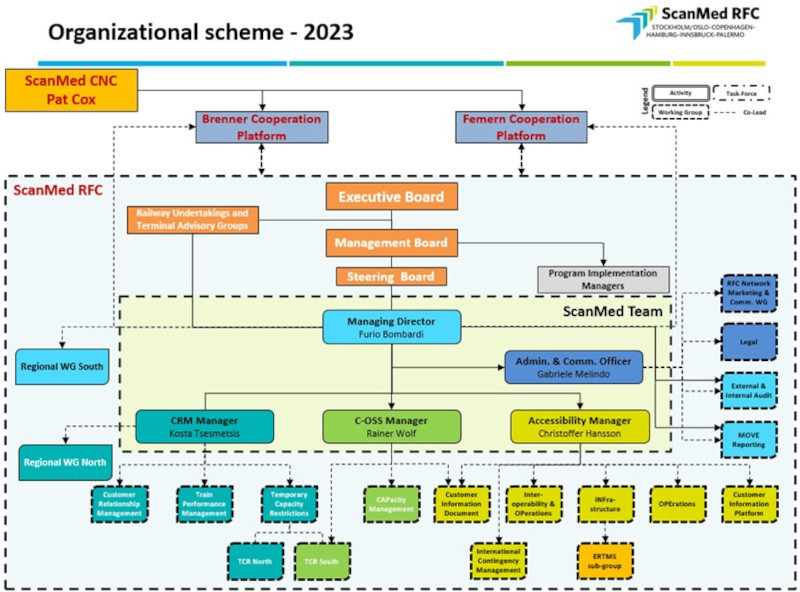The constant focus on the market requires an increasing involvement of end customers in the supply chain. The Scandinavian-Mediterranean Freight Corridor therefore intends to simplify access to the network and the services offered to transport companies and shippers, in order to make the use of railways easier and more convenient. In this respect, the Terminal Integrated Capacity Offer (TICO) is an important product, which has grown from a pilot project into an integral part of the commercial offer of the Corridor involving an increasing number of terminals. The integrated commercial offer is currently being refined in consideration of the feedback from the railway undertakings.
In 2020, the second phase of the preliminary study “Longer and Heavier Trains”, aimed at estimating, for different time horizons, the capacity supply for the circulation of longer and heavier trains taking into account market developments and planned infrastructure investments, was completed.
A new market study on modal transport costs was completed in 2020 and provided an analysis of the costs of rail and intermodal transport along specific traffic relations in order to identify “key lessons learned” for the further development of the commercial offer and an improvement of market knowledge to facilitate the acquisition of new customers.
The Scandinavian-Mediterranean Corridor was the first European freight corridor to apply International Contingency Management (ICM), the international emergency management process shared by all European infrastructure managers in the event of unplanned disruptions to international rail traffic, on a real case basis. The procedure was applied on a real-life case for the management of the disruption of rail traffic that occurred on the Italian network along the Brenner adduction line in December 2020. In this case, the Scandinavian-Mediterranean Corridor organised the ICM meetings during which the Infrastructure Managers and Corridors involved (RFI, ÖBB-I, DB Netz, SBB-I, Baltic-Adriatic Freight Corridor and Rhine-Alpine Freight Corridor) cooperated in order to identify the best options for re-routing the traffic affected by the disruption and to agree on a harmonised communication strategy towards the railway undertakings.
In order to improve the competitiveness and attractiveness of international freight transport on the Munich-Verona line, a Task Force coordinated by RFI, ÖBB-I and DB Netz was set up at the beginning of 2020 under the aegis of the Scandinavian-Mediterranean Corridor to improve traffic management and optimise capacity management.
The Task Force initiated and completed the evaluation of the European agreements (bilateral and trilateral) currently in force between the three Infrastructure Managers on traffic planning and management and identified actions for their rapid updating and extension that were tested during the pilot project during 2021. In parallel to carrying out the pilot phase, the Task Force aimed to involve the railway undertakings in the process to identify and implement actions under their direct responsibility.
The Munich-Verona line is a key link in the Scandinavian-Mediterranean Corridor, of which the future Brenner Base Tunnel (due to become operational in 2032) will be a key strategic infrastructure for the efficient international transport of goods. Building on the positive results achieved in the pilot project, the Brenner Axis Task Force is developing actions applied to the southern section of the Corridor which, starting with the definition of a new optimised short-term planning procedure and the introduction of a new communication flow between the traffic control centres, have led to the implementation on a permanent basis of a structured system of periodic performance monitoring.
These operations were carried out to complement the activities of the Brenner Corridor Platform (BCP), an international organisation that works with experts to develop proposals concerning infrastructure improvement, train path management, terminal handling and issues of interoperability, logistics and environmental impact with a time perspective after the opening of the Brenner Base Tunnel. As recognised by the European Commission, this initiative represents a reference and best practice for other rail freight corridors, key routes and the European rail network in general.
Under the leadership of European Coordinator Pat Cox and the active contribution of the Corridor, and after an initial phase of consolidation, the BCP has begun to produce concrete results, primarily a common forecast of traffic flows for passengers and freight in 2030 and 2040. A second significant result was the assessment of the still available capacity of the railway lines for the same years, in order to identify bottlenecks and allow the development of appropriate corrective actions. Three working groups dedicated to infrastructure, operational and environmental issues and a pilot project aimed at overcoming the main obstacles to a seamless rail link between Verona and Munich were defined in 2022.

